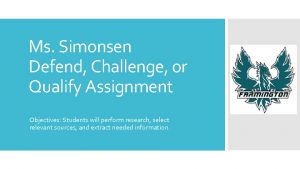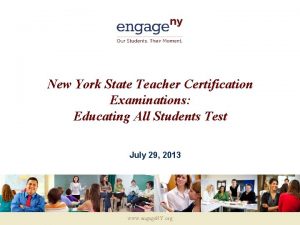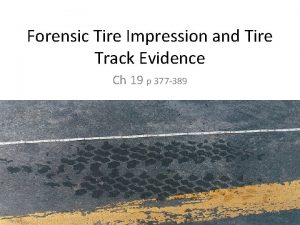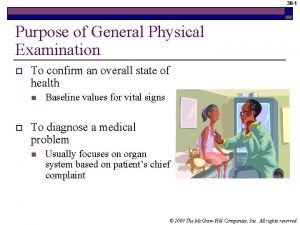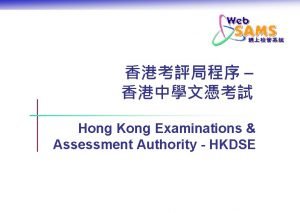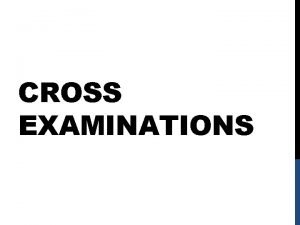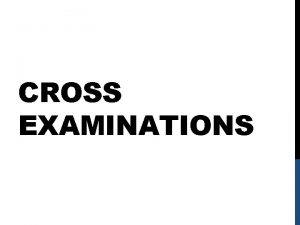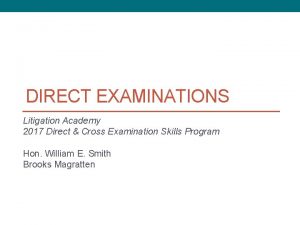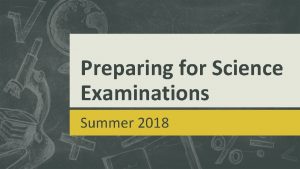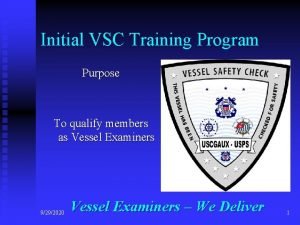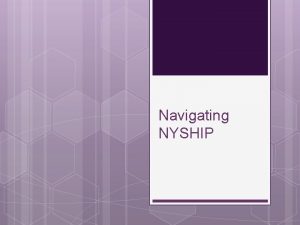DIRECT EXAMINATIONS GOOD DIRECT EXAMINATIONS 1 Qualify the














- Slides: 14

DIRECT EXAMINATIONS

GOOD DIRECT EXAMINATIONS… 1. Qualify the witness 2. Sets the scene 3. Lays out details

1. ) QUALIFY THE WITNESS • Describe the witness in a way that makes them seem… • competent or • Sympathetic • Qualify the witness by… • Developing witness’s background to make testimony relevant & real • The key is to personalize the witness without becoming tedious or obvious

EXAMPLES OF QUALIFYING DETAILS • Who they are? • Why they are here? • What experience do they have? • How educated are they? • Where do they live? • Etc…

2. ) SETS THE SCENE • How does the witness know what he/she knows? • Did he/she observe something? • What did he/she hear? • What are some specifics of the scene? • • • Building Lighting Street Room Decorations In setting the scene, you are showing that the witness testifies from personal knowledge.

3. ) LAYS OUT DETAILS • What happened? • Specific details • Who was involved? • What was the sequence of events? • What was the time?

PREPARING YOUR DIRECT… • Determine your goals • Select topics • Organize key topics • Select key words • Incorporate theme • Anticipate problems • Use open-ended (NOT LEADING) questions • Practice with the witness

1. ) DETERMINE THE GOAL What do you intend to accomplish with this witness? Why are you calling this witness to the witness stand? • To establish legally significant facts? • To corroborate another’s testimony? • To get a document into evidence? Your goal will depend on your overall case theory and strategy.

2. ) SELECT TOPICS Pick and choose what is important. • Use what is important; discard the rest Most often, witnesses are called to establish some legally significant facts. • Be CLEAR on the facts you want the witness to establish Don’t shy away from “negative” topics, but be sure to undercut any potential cross-examination of the witness. • If something negative will come out on cross, bring it out first

3. ) ORGANIZE TOPICS Goal is to tell a coherent and interesting story Story should flow naturally • Conversation in direct. Explanation in cross. ```` Decide what documents will be introduced to the witness and where in the direct these documents will be introduced

4. ) SELECT KEY WORDS Wording should reflect overall theme of the case Choose words WISELY. Words MATTER!! • If witness described attack as “ferocious” in witness statement, make sure he/she uses the same word during the direct Use descriptive words to paint a more vivid picture for the jury

5. ) ANTICIPATE PROBLEMS Every statement has its weaknesses. Your job is to minimize those weaknesses. • Jury should remember the good & forget the bad Anticipate attacks during the cross examination Choose how you will handle the attacks. Will you… • Let your witness talk about it during the direct so they may explain it themselves? • Wait and see & address the weakness in the redirect?

6. ) USE OPEN-ENDED QUESTIONS Who… What… Where… When… Why… How… Questions may NOT be leading. Leading questions may be objected to in a direct examination

7. ) PRACTICE WITH THE WITNESS MOST IMPORTANT PART!! It is obvious if the lawyer/witness combo has not practiced Create the direct together Direct should sound natural, conversational • Should NOT sound like an interrogation
 Defend challenge qualify
Defend challenge qualify Good deeds good thoughts
Good deeds good thoughts When is afternoon and evening
When is afternoon and evening Buenas tardes good afternoon
Buenas tardes good afternoon You are good you are good when there's nothing good in me
You are good you are good when there's nothing good in me Good afternoon students
Good afternoon students New york state teacher certification exams
New york state teacher certification exams Tire impression
Tire impression Prayer before exam st joseph of cupertino
Prayer before exam st joseph of cupertino University of auckland compassionate consideration
University of auckland compassionate consideration General physical exam
General physical exam Examinations.ie marking scheme
Examinations.ie marking scheme Web sams
Web sams Hát kết hợp bộ gõ cơ thể
Hát kết hợp bộ gõ cơ thể
